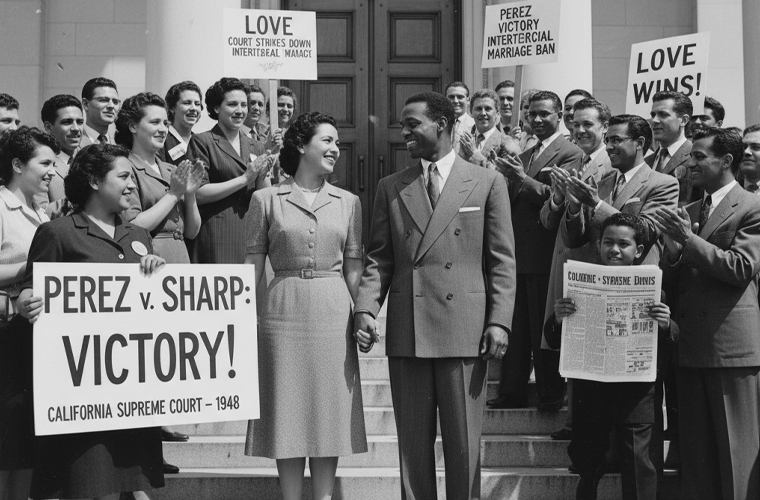A Landmark Victory Against Anti-Miscegenation Laws
In 1948, the California Supreme Court made history by striking down the state’s anti-miscegenation statute in Perez v. Sharp, marking the first successful legal challenge to laws banning interracial marriage in the United States. This groundbreaking decision not only reshaped California’s legal landscape but also set a precedent for dismantling racial discrimination in marriage laws nationwide, culminating in the U.S. Supreme Court’s 1967 ruling in Loving v. Virginia.
Background of the Case
Anti-miscegenation laws, which prohibited marriage between people of different races, were deeply entrenched in the United States, particularly targeting unions between whites and non-whites. In California, these laws dated back to the state’s early history, reflecting widespread racial prejudices of the time. By the 1940s, California’s Civil Code Section 60 declared marriages between “white persons” and “Negroes, Mongolians, members of the Malay race, or mulattoes” void.
The case of Perez v. Sharp arose when Andrea Perez, a Mexican-American woman, and Sylvester Davis, an African-American man, were denied a marriage license in Los Angeles County in 1947. Although Perez was classified as “white” under California law due to her Mexican heritage, the county clerk refused to issue the license, citing the state’s anti-miscegenation statute. The couple, represented by attorney Daniel G. Marshall, challenged the decision, arguing that the law violated their constitutional rights.
The Legal Battle
The case reached the California Supreme Court, where the central question was whether the state’s ban on interracial marriage violated the Equal Protection Clause of the Fourteenth Amendment to the U.S. Constitution. The court also considered the role of religious freedom, as Perez and Davis, both Catholics, argued that the law infringed on their right to marry in accordance with their faith.
In a 4-3 decision on October 1, 1948, the California Supreme Court ruled in favor of Perez and Davis. Justice Roger J. Traynor, writing the majority opinion, argued that the anti-miscegenation law was unconstitutional because it arbitrarily discriminated based on race. He emphasized that marriage is a fundamental right and that denying it on racial grounds lacked a compelling state interest. The court also addressed the religious argument, noting that the law impeded the couple’s ability to participate in the sacrament of marriage, further undermining its legitimacy.
The dissenting justices, however, argued that the state had the authority to regulate marriage and that such laws served a societal purpose by preventing racial tensions. This perspective reflected the prevailing attitudes of the era, which the majority opinion directly challenged.
Impact and Legacy
The Perez v. Sharp decision was a monumental step forward in the fight against racial discrimination. By striking down California’s anti-miscegenation law, the court invalidated a significant barrier to interracial unions, setting a powerful legal precedent. The ruling was particularly significant because it was the first time a state supreme court had overturned an anti-miscegenation law, inspiring similar challenges across the country.
The decision also laid the groundwork for the U.S. Supreme Court’s unanimous ruling in Loving v. Virginia in 1967, which invalidated all remaining anti-miscegenation laws nationwide. Perez v. Sharp highlighted the intersection of racial equality and personal freedom, demonstrating that laws rooted in prejudice could not withstand constitutional scrutiny.
Beyond its legal impact, the case resonated on a human level. Andrea Perez and Sylvester Davis’s courage in challenging systemic racism paved the way for countless couples to marry without fear of legal repercussions. Their victory underscored the power of individual action in dismantling discriminatory laws.
Perez v. Sharp stands as a landmark in American legal history, marking the beginning of the end for anti-miscegenation laws. The California Supreme Court’s 1948 decision not only affirmed the fundamental right to marry but also challenged the racial hierarchies embedded in American society. By striking down a law rooted in discrimination, the court took a bold step toward equality, leaving a legacy that continues to inspire the fight for justice and human rights.

